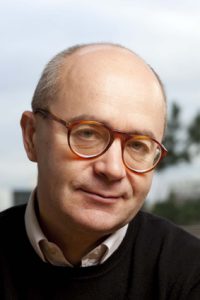Date: Friday, June 3rd, 10:30-12:00
Venue: Room 610, 6th floor, Administration Bureau Bldg. 2, The University of Tokyo
Speaker: Christophe Lécuyer, Professor of the History of Science and Technology, Université Pierre et Marie Curie-Paris 6, France, and Senior Research Fellow, Charles Babbage Institute, University of Minnesota, United States
Open to all, upon registration
Abstract :
The landscape of research and innovation has experienced significant changes since the early 1980s. One of these changes has been the appearance of new forms of innovation governance such as Moore’s Law and the technology roadmaps for semiconductors. How did these forms of governance emerge? What social and economic forces presided over their appearance? This paper shows that Moore’s Law, the statement that the number of transistors per microchip doubles every two years, emerged as a multipurpose tool in Silicon Valley in the first half of the 1960s. It was a technology of comprehension and persuasion; it was a marketing and promotion tool; it was a competitive device; and it was a contrivance used to allocate engineering resources and guide the development of new semiconductor technologies at the firm level. From the early 1990s to the mid-2010s, this multipurpose instrument became the centerpiece of a new governance structure in the microelectronics industry: the technology roadmaps for semiconductors. In response to fierce competition from Japan, US corporations used Moore’s Law to guide, plan and coordinate the development of device, process, and design technologies across the whole industry. Thereby, they accelerated the miniaturization of microchips and the digitalization of many industrial sectors. In the 1990s and 2000s, other industries such as nanotechnology, biotechnology and photovoltaic cells adopted similar modes of innovation governance.
bio:

Christophe Lécuyer is professor of the history of science and technology at Université Pierre et Marie Curie-Paris 6 and senior research fellow at the Charles Babbage Institute at the University of Minnesota. He taught at MIT, Stanford University, and the University of Virginia. He also held senior research appointments at Collegium de Lyon and the Institute for Advanced Studies at Central European University. He is known for his research on Silicon Valley and the history of high technologies. He is the author of Making Silicon Valley: Innovation and the Growth of High Tech, 1930-1970 (MIT Press, 2006) and the co-author of Makers of the Microchip: A Documentary History of Fairchild Semiconductor (MIT Press, 2010). He is a graduate of the Ecole Normale Supérieure and received his Ph.D. from Stanford University.
Hosted by:
Science, Technology, and Innovation Governance(STIG) ,
The University of Tokyo
STIG@pp.u-tokyo.ac.jp
05.24.2016